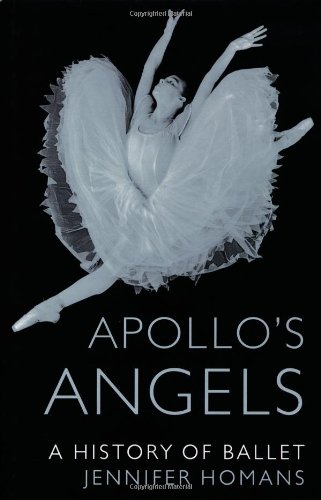
I must confess I haven’t yet read Jennifer Homans’ acclaimed but controversial history of ballet, Apollo’s Angels. I’m working hard on my second novel and have been knee deep in prison and cop memoirs and haven’t had time for much outside reading. I hope to read it soon though.
In the meantime, I have read some of the reviews, including Laura Jacobs’ in the WSJ and Toni Bentley’s in the NY Times. The two reviews focus on very different aspects of the book so it’s interesting to read both of them. Bentley says Homans is best on Balanchine (both Bentley and Homans danced with him). But Jacobs find the earlier sections enlightening as well.
The controversial aspects of the book seem to be toward the end when Homans argues that, for various reason (but according to Bentley many of them being that Balanchine has passed and his legacy is not being kept alive), ballet is a dying art.
I don’t want to go on too much since I haven’t yet read the book, but I will say that ballet seems to be alive and well in many European and Latin American countries. I do notice a real influx of visitors to my blog whenever the big European stars perform with ABT. I don’t think Roberto Bolle, Alina Cojocaru and Natalia Osipova fans think ballet is dying and certainly not because Balanchine is no longer with us. Ballet may be less popular in this country since the Baryshnikov era passed though, and it remains to be seen whether movies like Mao’s Last Dancer and Black Swan can do anything to revive it. I’m doubtful but want to be hopeful. I think it’s more likely that Natalie Portman marrying Benjamin Millepied will draw audiences to ballet than the actual movie will.
But then I recently ran across this interview with Homans over at the Ballet Bag, a London blog. At the beginning of the post, the writers say audiences there have been dwindling a bit and they’re worried about the future of the art form as well. Which scares me.
Anyway, has anyone read the book?
Another thing I wanted to call attention to is the book cover. The top one is the British cover, the second the American. Which do you guys like better, and think will sell more books? Just about every single time I see a European cover beside an American cover, I like the European better. But maybe it’s just me.







I love the European cover! No wonder ballet seems “dead” here and “alive” there…
Oh good – I’m glad it’s not just me!
Homan may be a tad biased about ballet dying after Balanchine since she danced with him. Ballet may be less popular here in the States, but dance overall is booming, isn’t it? Hip hop is certainly prevalent and contemporary is getting a lot more attention because of all the television shows.
I agree with you, Lizzie. For people who think that Balanchine was the epitome, well, then yes, ballet is dying. But there is so *much* going on in dance. There’s a nice quote somewhere in the new issue of Dance Magazine about how this new and young generation of dancers is going to “kill” it–I think it’s Daniel Ulbricht talking about a young NYCB dancer. I agree. If you spend time in dance studios, then you see how much cross fertilization there is in dance–including ballet–and that will only lead to new and interesting things.
Also, Tonya, check out MaCauley’s article today on the subject. I like that he sees such promise in Ratmansky.
Yeah I totally agree with you guys. According to the Bentley review (and to Haglund, who saw her appear on Charlie Rose, which I missed: http://haglundsheel.typepad.com/haglunds_heel/2010/12/the-bala-lama.html), she is really biased in favor of Balanchine. And if you’re going to define ballet totally in terms of that, they yes, it probably is dying in the U.S. given that he’s gone and there’s no choreographer today whose work is like his. But there is so much more than Balanchine!
Marie, I’ve been so buys, but I will read that article!
I know this post has been up for a year, but I wanted to let you know I just finished that book. Or, tried to, anyway. Frankly, when it got to the parts I was actually involved in, the dance boom of the 70’s and 80’s, and their choreographers, I thought she was full of it. She was downright hateful and disrespectful of some really great choreographers I danced for, (however briefly). Her venom reached its peak, IMO, when she ragged on a couple of gay choreographers who had the temerity to step out of the closet in their work. Which is weird, because she blasted Julie Kavanaugh’s biography of Rudi Nureyev, because she felt the author focused on Rudi’s sexuality too much. To be fair, she also called Macmillan’s work, “darkly violent”. Wow. He also choreographed two women dancing together romantically, which Homans described as “soft porn”. I’m guessing that that particular transgression earned the wrath of the author for the rest of his work. In short, I am amazed that the Times called her writing “detached”. Detached from what? reality?
And speaking of, how can you write about the arts community (especially the dance) in the 80’s without mentioning, not even once, the plague that killed off at least two generations of talent. Talent we will never know that were mowed down in the spring of life, leaving us bare for at least a decade, and probably the biggest reason Balanchine hasn’t been replaced? Really? Really?
I may be wrong, but history is supposed to be the chronical of what happened during a period of time. Not the disturbed ramblings of a former dancer with a P.H.D.
Cheers,
Jeff